Webmail is a service that allows users to access their email accounts through a web browser, such as Chrome or Firefox, rather than using a standalone email client.
Two of the most popular web hosting control systems, cPanel and Plesk, come with webmail applications pre-installed. These allow you to access your emails with absolutely zero configuration instantly.
For many years, cPanel and Plesk included three webmail clients:
- Horde
- Roundcube
- SquirrelMail
Unfortunately, both Horde and SquirrelMail are poorly maintained and have (or soon will be) been removed from cPanel and Plesk.
While this guide highlights the key differences between the three webmail applications, in all likelihood, if you use cPanel or Plesk, your only choice will be Roundcube.
Let’s get started.
Horde Vs. Roundcube Vs. SquirrelMail Summary
The table below shows the main differences between the three webmail applications:
| Horde | Roundcube | SquirrelMail | |
|---|---|---|---|
Application website | |||
Included in cPanel & Plesk? | It will be removed in early 2023. | Yes. | No. |
Actively Maintained? |
|
|
|
Interface type |
|
|
|
Composition features: |
|
|
|
Organization features: |
|
|
|
Additional features: |
|
|
|
Recommended for: | Not recommended. | Users who need a user-friendly web interface with some additional features available. An extensive plugin collection is available for system admins \ enterprise users. | Not recommended. |
Roundcube In-depth Look
The Roundcube webmail application comes with two different interface skins; Elastic and Larry.
- The latest, most modern skin is Elastic.
- Support for the Larry Skin is now depreciated and is expected to disappear from Roundcube shortly.
You can change your Roundcube application to the latest Elastic Skin by going to Settings -> Preferences -> User Interface and then selecting Elastic Skin in the options.
The images in this article show the Elastic Interface.
The Interface
The Roundcube interface in light mode:

The Roundcube interface in dark mode:
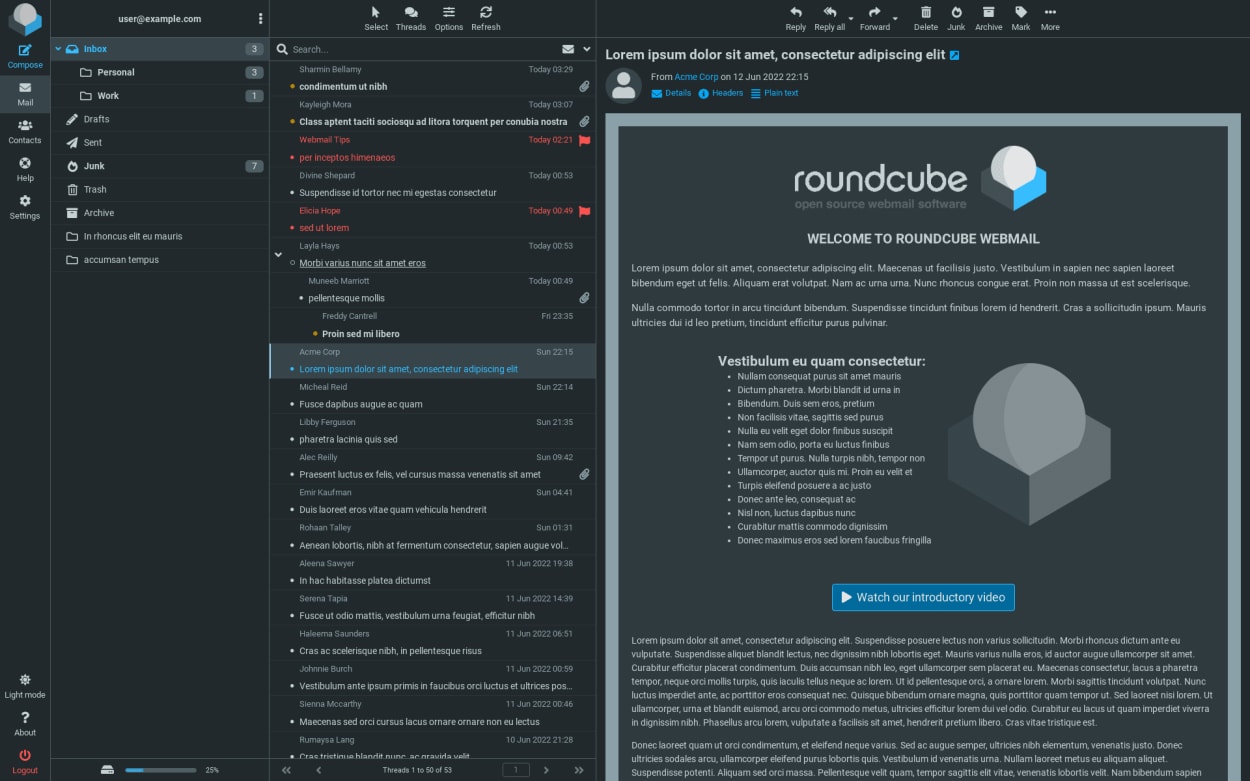
Unlike Horde, Roundcube takes you directly to your email inbox when you log in. No dashboard summarizes your emails, contacts, to-do lists, etc.
The Mailbox view is customizable via Settings -> Preferences -> Mailbox View. Here you can choose from a 3-panel configuration, including a mail preview, a widescreen 3-column view, or just a list of emails (without preview).
The interface is very modern thanks to a default theme called “Elastic,” created by a user called Aleksander Machniak.
The latest theme includes a Dark Mode option.
Mail Composition features
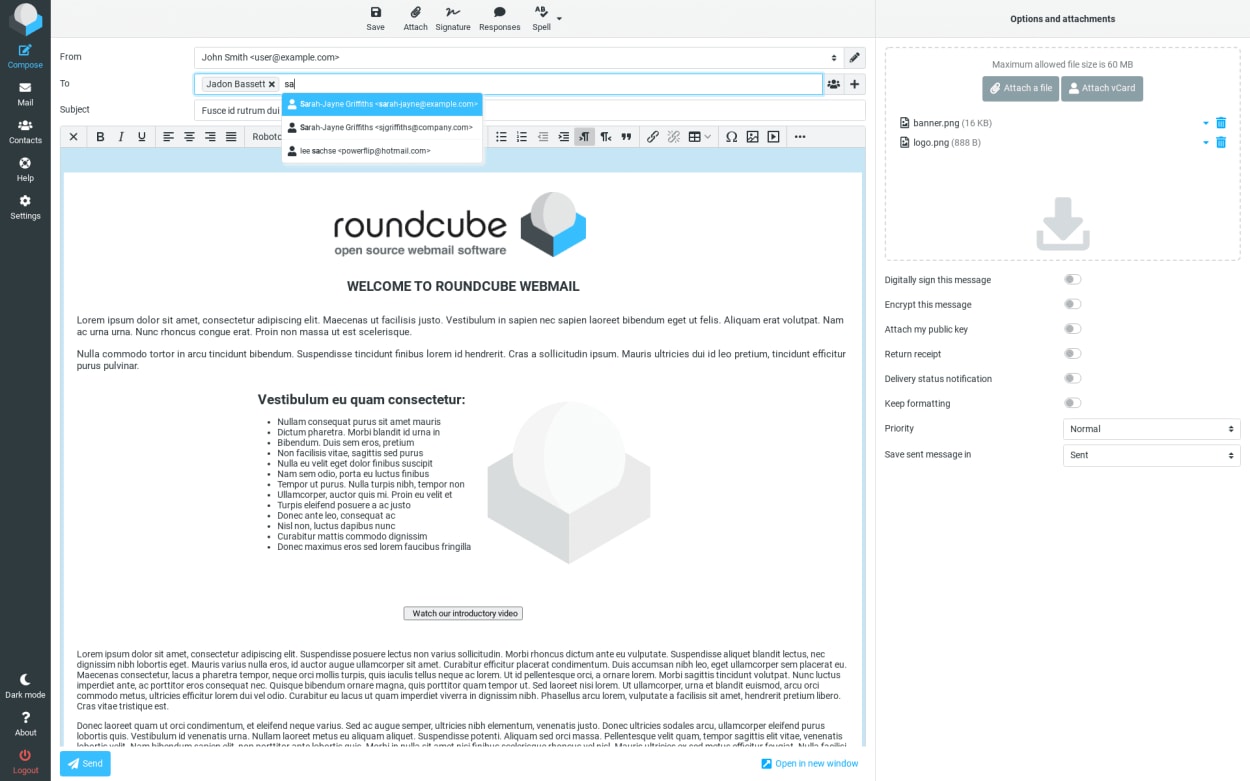
Writing an email in RoundCube is easy. Click the “Compose” button in the main menu bar from the main Inbox screen. You can then select from the “Editor Type” dropdown whether to write your email in Plain text or HTML.
When using HTML composition, a WYSIWYG will appear, making it easy to craft your message in HTML. You can add attachments, request return receipts and delivery status notifications, and choose where to save the email.
On the composition screen, your contacts will appear in the left sidebar, making it easy to select existing contacts.
RoundCube says that they have a spellchecker. However, despite being shown on the screenshot, it is not present in the default cPanel install.
Mail Organization features

There are many features that help to organize your webmail:
Drag-and-drop message management - Group and order messages easily by dragging and dropping them to your desired folder.
Folder manipulation - All the features you would expect to manage your webmail folders. Empty, Mark all as seen, don’t check for mail, create new mailboxes, etc.
Message flags - Flag messages so you can easily find them again or follow up at a later date.
Search mail - You can easily search through your email through the entire message, body, from, to, Bcc, Body, subject fields, date, current folder, all folders, and subfolders.
Threaded conversation view - This enables you to follow a chain of emails efficiently.
Privacy Protection - Automatic image blocking to protect privacy.
Spam filters - While Roundcube advertises spam filters as a function on their website, no such functionality exists on the default installation. Instead, you can use the cPanel spam filters, BoxTrapper, or SpamAssassin.
Additional features
Address book with Groups and LDAP:
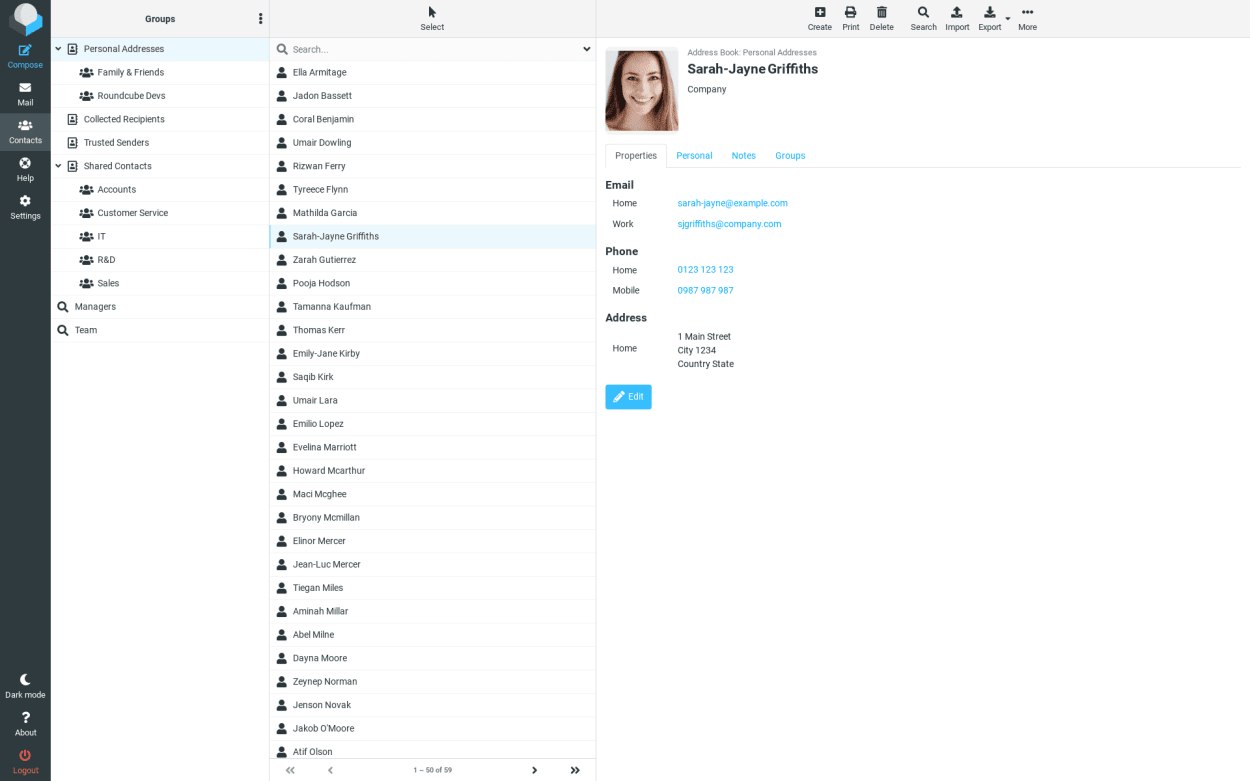
Fully featured address book with group functionality and LDAP (Lightweight Directory Access Protocol) connectors allowing anyone to locate contact information within a network (whether on the public Internet or a corporate intranet).
Contact management:
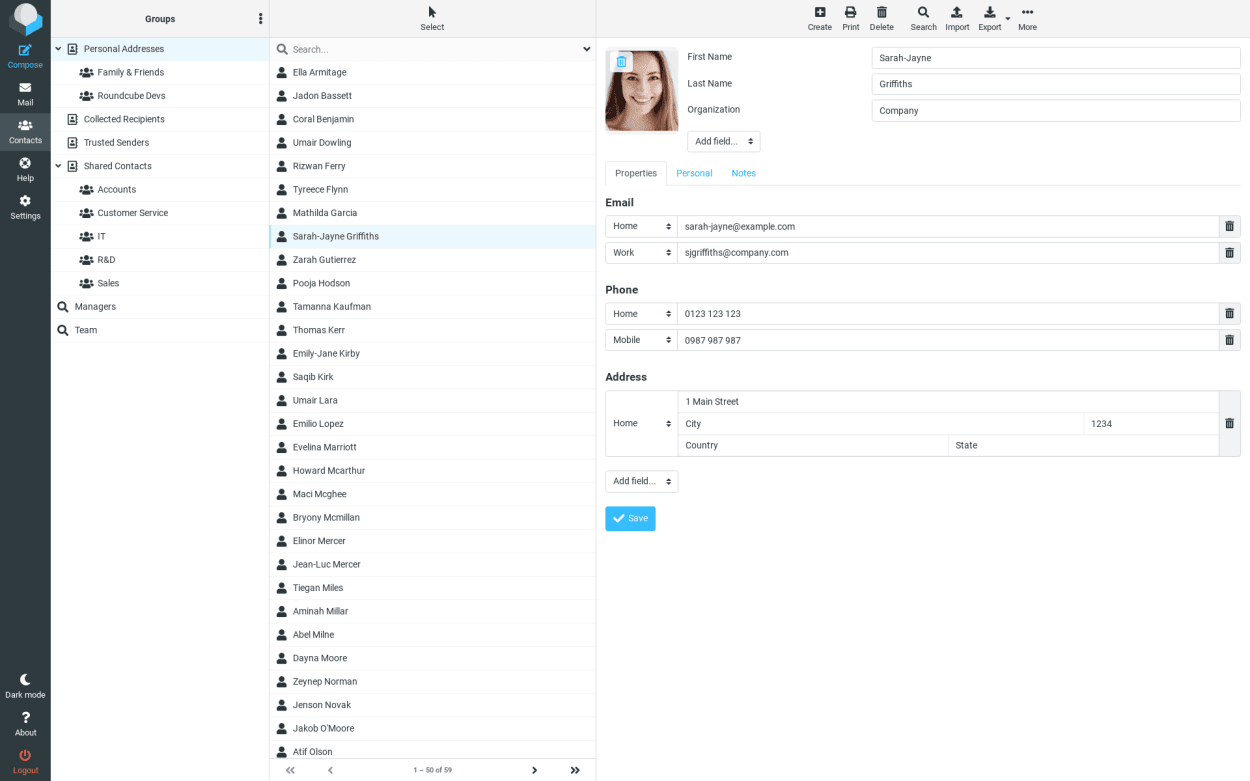
Powerful and extensible contact management features, allowing the recording of emails, addresses, job information, personal information, and more. Merely add the fields you require to flesh out as much or as little detail as you want.
Sender Identities:
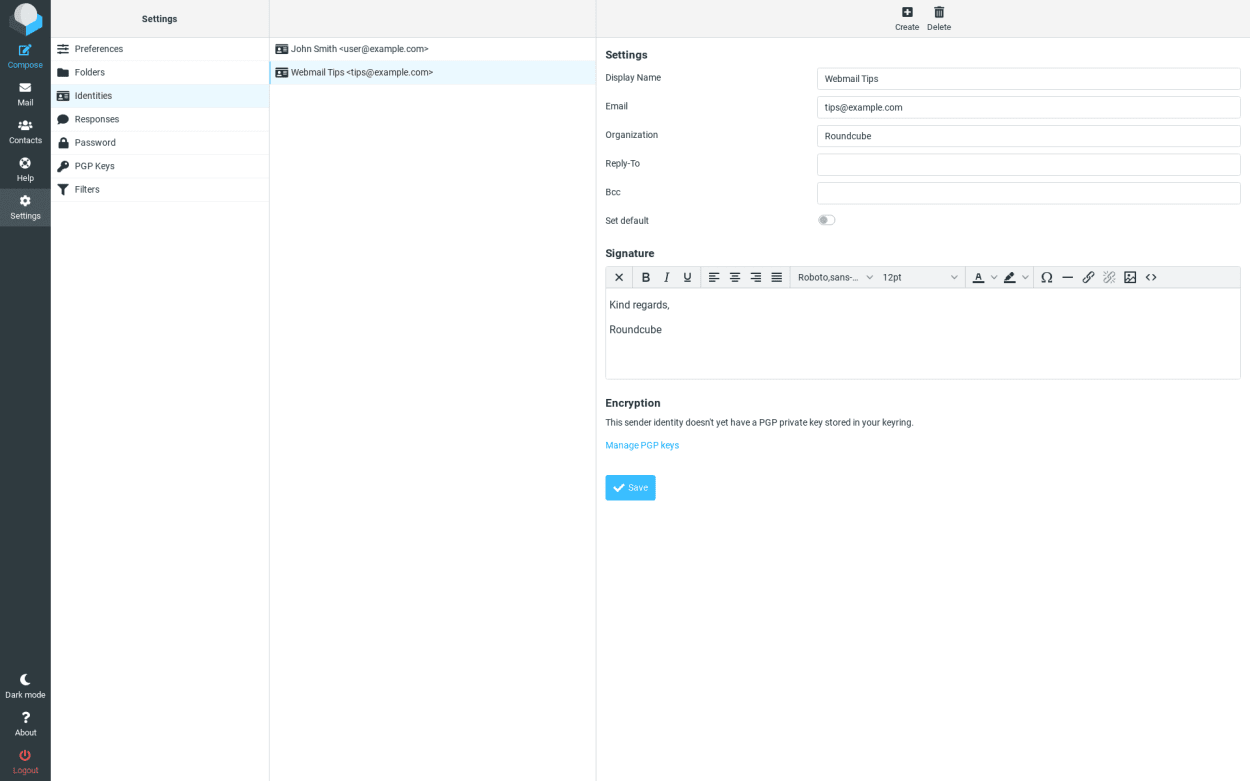
Utilize sender identities for differentiating between business email and personal email names, signatures, and sign-offs.
Calendar:
The Calendar functionality is now included in all cPanel and Plesk installations.

Summary
If you are familiar with desktop clients such as Outlook or Gmail, you will feel at home with RoundCube, thanks to the third-party interface skin called “Elastic”, now included as the default.
RoundCube’s email functionality is excellent. It features an address book, sophisticated searching, all the usual folder and email management features you would expect, and a calendar.
There is no spell checker (your web host will have to install these, but you can search all the plugins here).
For enterprise usage, there is a Plugin API for flexible extensions, an extensive array of plugins, and built-in caching for fast mailbox access & to reduce server loads. RoundCube comes into its own when managed by your own server admin, who can install third-party plugins.
Roundcube is the smart choice when choosing your preferred webmail application.
Horde In-depth Look
The Interface
The main dashboard, by default, shows Mail Statistics, Calendar, Email Filters, Tasks, Notes, and Contact Search.

The dashboard is fully customizable by clicking on the green add content button. You can have up to 12 blocks in a 3 x 4 pattern. Additional options include weather, tag cloud, newest unseen messages, webpage embed, calendar, and bookmarks (including most used).
The Email Dashboard has a three-pane format with an email view pane consistent with many other webmail services like Gmail or Outlook.

Overall, the Horde interface is smart, relatively modern, and customizable.
All the features are easy to access, and the administrative area is intuitive.
Further configuration options are available in the toolbar under the cog-icon -> preferences -> mail option. Here you can configure how messages are displayed, preferences for viewing the listing of messages in a mailbox, and even folder navigation display preferences.
Mail Composition features

Writing an email in Horde is easy. To start, go to Mail -> New message, and a popup will appear with a simple interface. You can switch between HTML composition and text.
When using HTML composition, a WYSIWYG will appear, making it easy to craft your message in HTML. You can add attachments (including contact information), save the sent message to your sent folder, set priority, and even request a read receipt (under other options).
The spell checker supports 19 languages, although three are for English variants.
Mail Organization features

There are many features that help to organize your webmail, including:
Folder manipulation - All the features you would expect to manage your webmail folders. Empty, Mark all as seen, don’t check for mail, create new mailboxes, etc.
Mail filters - Filter by whitelist \ blacklist as well as create new rules. You can filter by any email field and then make an action such as delete, deliver, or copy and mark the message as seen, flagged, answered, or deleted.
Message flags - Manually or automatically set flags to a specific message.
Search mail - You can easily search through your email by searching through the entire message, body, from, recipient, and subject fields, as well as utilizing the advanced search that allows setting date and email size among many customizable options.
Threaded conversation view - Easily follow conversations with the threaded view.
Additional features
The Horde Calendar

The Horde Calander utilizes a calendar application known as Kronolith.
Kronolith features repeating events, all-day events, tags, shared calendars, remote calendars, CalDAV support, iTip/iCalendar support, free/busy information generation, and management of multiple users through Horde Authentication.
Kronolith also features an API that can integrate with any enterprise backend.
The Horde Task List

The Horde Tasklist application, known as Nag, features to-do items, things due later in the week, and task list management. You can filter by incomplete, and future tasks and view completed tasks. The application also allows for sub-tasks and even shared task lists.
Horde Notes

The Horde Note application is known as Mnemo. It allows you to keep text notes that are unsuited for a to-do item, event, or contact.
Horde Note supports Tags for easy categorization, search functionality, and shared Notepads. Notes can be imported from CSV and vNote files and exported to CSV files. You can also password-protect notes.
Horde Address book

Turba is the name given to the Horde address book/contact management program. It provides a generic frontend for searching and managing LDAP, SQL, IMSP, and several other contact sources.
You can import \ export contacts and even share address books between users.
Summary
Horde is a webmail client that is designed for browser-based usage. It is fully enterprise-ready and includes an API to integrate Horde into the existing backend infrastructure. Horde also offers professional services, which they boast have helped with significant deployments varying between 100,000 and 5 million users.
If you do not intend to use Horde exclusively (i.e., only when out of the office), you can. Access is available via IMAP and POP3 to import emails from your business server.
The dashboard is a powerful feature if you use Horde daily as your go-to application. It enables you to see all your information at a glance. You can add widgets to the dashboard, such as the current weather and RSS feed, or even embed a web page (such as your favorite news website).
Getting started is easy, as an email address created in cPanel is automatically configured for use in Horde. There is no need to configure your mail client at all.
Horde will soon be depreciated from cPanel and Plesk, so that may be a dealbreaker.
SquirrelMail In-depth Look
The Interface

- SquirrelMail uses a relatively old two-pane list format, so you cannot preview the email message unless you click on it.
- There is no dashboard summary. You immediately view the list of messages when you log in.
Mail Composition features

- Attachments - Easily attach files to your emails. Our default install allowed files up to 50MB.
- Text-only composition - Only text emails can be sent, so there is no WYSIWYG or Word-like toolbar to help you compose your messages.
- Read \ Delivery receipts - You can receive a read receipt or be notified of successful delivery.
- Signatures - Easily add your signature to your email.
- Priority Flag - Flag your email by priority - Low, Normal, or High.
In the screenshot, you will also see spell-checking and auto-translate functionality. These are not installed by default and require your system admin or web host to install the requisite plugins.
Organization features

- Folder manipulation - Easily create folders to sort your emails.
- Message flags - Flag important messages for follow-up.
- Message highlighting - Based on given criteria, incoming messages can have different background colors in the message list to easily distinguish important messages or select messages based on your own rules.
- Search mail - You can easily search through your email through the entire message, body, from, to, Bcc, Body, and subject field. You can choose to search in specific folders.
- Threaded conversation view - Choose between the threaded view to easily view replies to your emails or unthreaded view to sort strictly by date.
Additional features

- Address book - SquirrelMail has a simple address book allowing you to store a person’s Nickname, Email, First Name, and Last Name. There is also a field for additional info. You cannot add other fields.
Summary
SquirrelMail is a straightforward webmail client designed to be compatible across all browsers.
If you like how the web looked back in 1995, then the archaic design will be right up your street. Despite that, there is an air of simplicity about this webmail client that may well suit some people. It certainly grows on you, so it’s worth giving it a chance.
Looking at the screenshots on the SquirrelMail website, it appears to advertise features such as message translation and calendar functionality. On our default install, no such features existed, so you would require your system admin or web hosting provider to install these plugins for you. A large selection of plugins is available to extend the address book, change the message view, prevent spam, and more.
Which Webmail application is more popular?
Out of Roundcube, Horde, and SquirrelMail, Roundcube is overwhelmingly more popular.

Horde, Roundcube, or SquirrelMail? - Which is better?
Horde webmail - SquirrelMail will soon no longer be available in cPanel or Plesk on a default installation.
Roundcube webmail - This appears to be the most popular webmail application. The interface looks modern, and it is also straightforward to use. The software is actively being developed with new features and security updates. There is API integration and a full selection of plugins for enterprise users to extend its functionality.
SquirrelMail webmail - SquirrelMail is no longer available in cPanel or Plesk on a default installation.
In summary, you’ll probably want to use Roundcube. It is actively maintained and will soon be the only free webmail application offered by cPanel and Plesk hosting providers.
